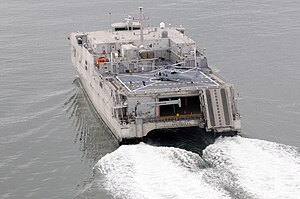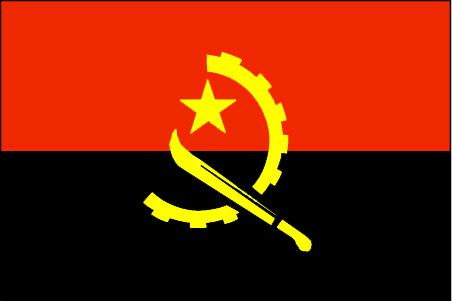Skip to comments.
Why Does One of the World’s Smallest Navies Want One of the World’s Biggest Warships?
War is Boring ^
| 12/04/2013
| David Axe
Posted on 12/04/2013 9:52:50 PM PST by sukhoi-30mki
Angola’s bizarre, rumored aircraft carrier ambition David Axe in War is Boring Angola is in the process of acquiring the recently-decommissioned Spanish aircraft carrier Principe de Asturias, according to one news report. The entire Angolan navy has just 1,000 sailors. The 643-foot-long Principe de Asturias needs 830 sailors to fully function.
No, this does not make a lot of sense. After all, Angola has no overseas military alliances and no major naval rivals. But if true, it is consistent with the country’s ongoing re-armament, which also includes a squadron of Russian-made heavy jet fighters formerly used by India.
Necessary or not, Angola is potentially buying one of West and Southern Africa’s most powerful military arsenals.
Principe de Asturias commissioned in 1988 and for the next 25 years served as Spain’s flagship, carrying a squadron of Harrier jump jets and helicopters on peacekeeping patrols and training missions.
At just 16,700 tons displacement fully loaded, she’s among the smallest of the world’s aircraft carriers. Many of America’s flattops exceed 100,000 tons displacement. But Principe de Asturias still ranks among the world’s largest and most powerful warships, thanks to her ability to launch jets and helicopters.
While not exactly old, this year Spain replaced the diminutive flattop with a new, jet-compatible amphibious assault ship. Principe de Asturias was to be dismantled this year, but sudden interest from Angolan officials reportedly put that plan on hold. According to Spanish news Website Digital El Confidential, an Angolan delegation visited Ferrol shipyard to inspect the laid-up carrier.
Spanish officials have declined to confirm Angola’s interest. “There are still countries interested in buying the aircraft carrier, but nothing firm,” a government rep said.
Spain will reportedly sell Principe de Asturias to Angola along with four decommissioned patrol ships. The Angolan navy currently possesses only a handful of Russian-made attack craft each weighing in at just a few hundred tons displacement. The Spanish acquisitions, if they are truly more than rumors, will expand the Angolan fleet by an order of magnitude and compel the navy to add thousands of new sailors.
Whether Angola can recruit and train the required personnel is far from certain. It’s equally unclear whether the African state can afford to operate Principe de Asturias on more than a token basis. In 1997, Thailand commissioned a small flattop based on Principe de Asturias’ design but has found it nearly impossible to keep the carrier and her Harriers in front-line service.
In her final years in Spanish service, Principe de Asturias and her planes and copters reportedly cost as much as $100 million a year to operate. Huge and sparsely populated, Angola sits atop vast mineral wealth that accounts for much of the country’s income but is concentrated in the hands of elites.
Angola hasn‘t indicated that it is trying to also purchase helicopters and Harriers to fly from the flattop.
The carrier is not Angola’s only high-profile military acquisition. The developing country is also getting 18 used Su-30 twin-engine fighters from Russia. Previously operated by the Indian air force, the Su-30s were returned to Russia when New Delhi upgraded its air arm. While lacking the latest avionics, the Su-30s are still among the world’s most powerful fighters, roughly equivalent to the U.S. F-15.
As with the Principe de Asturias, it’s far from certain that Angola can recruit pilots and afford to fly the Su-30s. West and Central African states have a strong tradition of paying mercenaries from Ukraine and other European countries to pilot their warplanes.
Besides being wasteful in a country that’s still one of the world’s least developed, Angolan arms acquisitions actually pose a security threat … to Angolans. The main mission of the 100,000-strong armed forces—the army is the largest of the military branches—is to maintain internal security. Angola suffered a decades-long civil war that ended in 2002. Armed groups are still active in the countryside.
But it’s hard to say how exactly an aircraft carrier helps maintain internal security. If Angola really is buying a flattop, it’s anyone’s guess why.
TOPICS: Foreign Affairs; News/Current Events
KEYWORDS: 2013; aerospace; aircraftcarrier; angola; aritimesecurity; carrier; davidaxe; flattop; navy; principedeasturias; spain; warisboring; warships
Navigation: use the links below to view more comments.
first previous 1-20, 21-40, 41-52 last
To: GeronL
LOL - yeah, and with some other words that would probably get me banned forever...
To: Billthedrill
South Korea has a bigger navy than the UK, insane.
42
posted on
12/05/2013 1:45:48 PM PST
by
GeronL
(Extra Large Cheesy Over-Stuffed Hobbit)
To: Pan_Yan
Well, that explains why Hillary’s pal Ambassador Joe Wilson has business dealings with Angola.
43
posted on
01/11/2017 9:20:33 PM PST
by
piasa
To: jospehm20; GeronL; sukhoi-30mki; Riflema
"We have more admirals than ships too." Near as I can tell, that's an exaggeration, though not by much.
First, you have to count submarines as "boats", not ships, which by tradition the Navy does.
Second, you'd have to count in some less than fully active (i.e., reserves or retired) to boost the number of admirals.
Still, in WWII there were 30 ships for every admiral, so that says a lot about how far we've fallen.
No doubt part of the explanation is that should the time come when we must rapidly expand the armed forces, there will be necessary leadership to fill the new slots.
44
posted on
01/14/2017 6:11:36 AM PST
by
BroJoeK
(a little historical perspective...)
To: TomasUSMC; Forward the Light Brigade; sukhoi-30mki
"I’d like to buy some Angolan imports....what do they import?" Before their civil war (1975-2002) Angolans exported mainly agricultural products such as bananas, coffee and sisal-hemp (a tough fiber used in ropes, carpets, footwear, etc.).
Today those are relatively minor and Angola's predominant exports (98%) are petroleum products and diamonds.
In the recent past those totaled approx. $55 billion per year compared to $25 billion in imports giving Angola a trade surplus of $30 billion per year.
Today's latest numbers are significantly lower...
As for mosques, Angola's Muslim population is circa 1%.
Most Angolans are Catholics, from their heritage as a Portuguese colony.
Finally, we might note that Angola has been the worlds number one importer of "special purpose ships" such as floating docks, fire-boats and dredges.
This may have something to do with keeping their capital city and major port operating smoothly.
45
posted on
01/14/2017 6:37:05 AM PST
by
BroJoeK
(a little historical perspective...)
To: sukhoi-30mki
The Duchy of Grand Fenwick wanted to bid but getting ship into the Alps was too difficult.
To: BroJoeK
A little exaggeration but not much. There were 234 commissioned ships (including submarines) in the Navy as per the US Naval Register, current as of 31 December 2016 . There are 223 active duty Admirals (O7-O10) now. That includes 162 Admirals assigned to the Navy plus 61 more Admirals assigned to joint billets as of 2016. This number comes from the 2016 report at the link below and does not include reserve component Admirals. The number of active duty Admirals has been reduced significantly since 2012 so I am not certain that it was an exaggeration in the past.
https://fas.org/sgp/crs/natsec/R44389.pdf
https://en.wikipedia.org/wiki/List_of_current_ships_of_the_United_States_Navy
To: jospehm20
Thanks, I've seen various numbers, not sure which ones should apply:
"The United States Navy has over 440 ships in both active service and the reserve fleet, with approximately 70 more in either the planning stages or under construction, according to the Naval Vessel Register and published reports."
Of those, as you posted, just 234 are "commissioned", the rest non-commissioned (105), ready-reserve (51) and other support ships (50).
Non-commissioned ships include such as USNS Spearhead class, and Mercy class hospital ships:
![]()


48
posted on
01/14/2017 12:39:33 PM PST
by
BroJoeK
(a little historical perspective...)
To: Vince Ferrer
“Straw Man?”
Quite possibly, but for whom, I wonder?
49
posted on
01/14/2017 12:47:33 PM PST
by
PLMerite
(Lord, let me die fighting lions. Amen.)
To: BroJoeK
I would go with the 234 commissioned number. PE Trump said he wants a 350 ship Navy. I am guessing that he does not intend to get there by scrapping 90 ships.
To: Fiji Hill
Angola's Flag:

51
posted on
01/14/2017 3:03:48 PM PST
by
Mycroft Holmes
(The fool is always greater than the proof.)
Class and type: Príncipe de Asturias-class aircraft carrier
Displacement: 15,912 tons standard,
16,700 tons loaded
Length: 195.9 m (643 ft)
Beam: 24.3 m (80 ft)
Draught: 9.4 m (31 ft)
Propulsion: 2 × Bazan-General Electric LM2500+ gas turbines in COGAG configuration, one shaft, 46,400 shp
Speed: 26 knots (48 km/h; 30 mph)
Range: 6,500 nautical miles (12,000 km; 7,500 mi) at 20 knots (37 km/h; 23 mph)
Complement: 830 (total); 600 ship crew, 230 air crew
Sensors and
processing systems: Raytheon SPS-52C/D 3D air search radar,
SC Cardion SPS-55 surface search radar,
ITT SPN-35A aircraft control radar,
FABA SPG-M2B fire control radar,
SELEX Sistemi Integrati RTN-11L/X missile approach warning radar,
Selex RAN 12 L target designation radar
Electronic warfare
& decoys: Nettunel electronic countermeasures unit,
Super RBOC,
Sensytech AN/SLQ-25 Nixie decoy
Armament: 4 × FABA Meroka Mod 2B CIWS,
12 × Oerlikon L120 20 mm guns
Aircraft carried: 29 fixed wing and rotary wing aircraft
Aviation facilities: 12° ski jump 46.5 m in length
52
posted on
01/14/2017 3:06:33 PM PST
by
mad_as_he$$
("It's a war against humanity!" Donald J. Trump)
Navigation: use the links below to view more comments.
first previous 1-20, 21-40, 41-52 last
Disclaimer:
Opinions posted on Free Republic are those of the individual
posters and do not necessarily represent the opinion of Free Republic or its
management. All materials posted herein are protected by copyright law and the
exemption for fair use of copyrighted works.
FreeRepublic.com is powered by software copyright 2000-2008 John Robinson


